Expert's Rating
Pros
- Pixel-packed 18-inch 4K Mini-LED display
- Two Thunderbolt 5 ports
- Top-tier multi-threaded CPU performance
- Excellent GPU performance
- PCIe 5 solid state drives
Cons
- Heavy and thick
- Mediocre keyboard, touchpad
- Very loud under load at high performance profiles
Our Verdict
The MSI Raider 18 HX AI isn’t a looker, but it packs incredible CPU and GPU performance.
Price When Reviewed
This value will show the geolocated pricing text for product undefined
Best Pricing Today
The MSI Raider 18 HX AI is the very model of a “desktop replacement” laptop. It’s big, it’s not much to look at, and it has a mediocre touchpad that implies users are really expected to connect a mouse.
That might leave some shoppers asking, “What’s the point?” That question is answered once the laptop is tossed into a demanding game or application. It might be thick, but the MSI Raider 18 HX delivers top-tier CPU and GPU performance. It even has gobs of RAM and a PCIe 5.0 solid state drive.
MSI Raider 18 HX AI: Specs and features
The highlight of the MSI Raider 18 HX AI’s spec sheet is undoubtedly the Nvidia RTX 5080. This new mobile GPU is destined to become the new go-to choice for gamers on the go, and here it has access to an impressive 175 watts of graphics power.
But the story doesn’t end there. The Raider 18 also has Intel’s new Core Ultra 9 285HX, which packs 24 CPU cores, and the model I reviewed had 64GB of RAM alongside a 4TB PCIe 5.0 solid state drive. It has a Mini-LED display, too.
- Model number: A2XWIG-418US
- CPU: Intel Core Ultra 9 285HX
- Memory: 64GB DDR5-6400 RAM
- Graphics/GPU: Nvidia RTX 5080 16GB
- NPU: Intel AI Boost up to 13 TOPS (Int8)
- Display: 18-inch 3,840 x 2,400 120Hz IPS Mini-LED
- Storage: 4TB M.2 PCIe 5.0 SSD
- Webcam: 1080p 30fps camera with physical privacy shutter, dual array microphone
- Connectivity: 2x Thunderbolt 5, 3x USB 3.2 Gen 2 Type-A, 1x HDMI, 1x 3.5mm combo jack, SD card reader
- Networking: Wi-Fi 7, Bluetooth 5.4
- Biometrics: Fingerprint reader, Facial Recognition
- Battery capacity: 99 watt-hours
- Dimensions: 15.91 x 12.09 x 1.26 inches
- Weight: 7.94 pounds
- Operating System: Windows 11 Pro
- Price: $4,499 MSRP
Cutting-edge hardware doesn’t come cheap, and the Raider 18 I tested rings up at an intimidating $4,499. That’s a lot, but if you glanced at the spec sheet and thought, “Eh, could be better,” MSI also offers a more extravagant configuration with Nvidia RTX 5090 graphics at $4,899.
The MSI Raider 18 HX AI is a hardware showcase. It has an Intel Core Ultra 9 285HX that sets new records in several benchmarks, and an Nvidia RTX 5080 GPU with performance close to RTX 4090, and a pair of PCIe 5.0 solid state drives that hit blistering read speeds of just over 13,000 MB/s.
MSI Raider 18 HX AI: Design and build quality
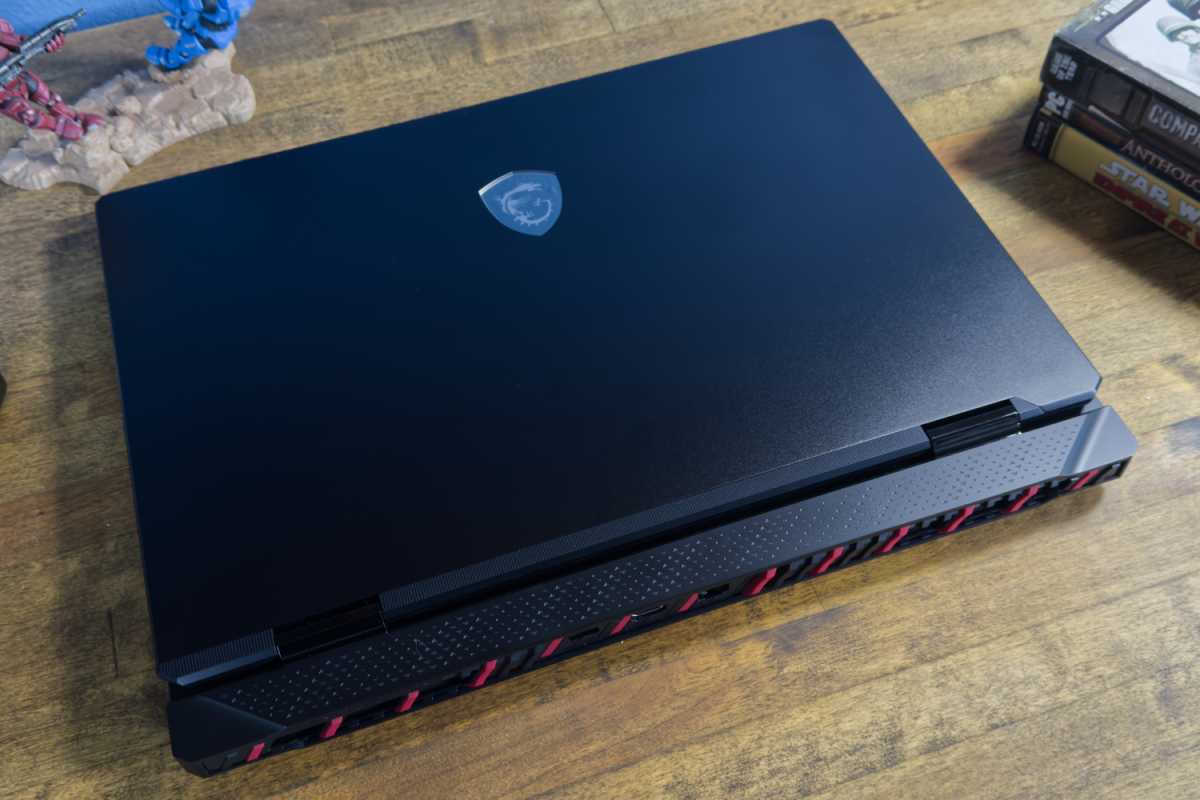
IDG / Matthew Smith
The MSI Raider 18 HX AI isn’t the company’s largest and most powerful laptop—that’s the MSI Titan—but it’s still a beefy boy. We’re talking nearly 8 pounds of heft and a profile that’s about 1.25 inches thick. That’s not unusual for a big, high-performance gaming laptop like the Raider 18, but it’s important to note. You’re going to notice when this laptop is in your bag, and it won’t even fit in many mid-sized backpacks.
Size aside, the Raider 18’s design is cohesive but not remarkable. It’s clad in black plastics with red accents, and while the materials look fine, they’re certainly not as luxurious as laptops that aim for a more professional look, such as Razer’s Blade 18. It’s also noticeably less extravagant than MSI’s Titan, which is more of a showpiece.
While it doesn’t make a strong first impression, the Raider 18’s build quality is solid. The plastics don’t provide the sense of solidity aluminum would offer, but the chassis is rigid when the laptop is handled, and the display doesn’t significantly warp as it’s opened and closed. Pressing hard on the keyboard reveals some flex, but that’s common for laptops of this size, and it didn’t stand out in normal use.
MSI Raider 18 HX AI: Keyboard, trackpad

IDG / Matthew Smith
A spacious keyboard with a numpad stretches across the MSI Raider 18 HX AI’s interior. While a few keys, like Caps Lock, are still ever-so-slightly smaller than typical, most keys are large. This includes the numpad keys, which, unlike so many laptops’ keyboards, are the same size as the primary alphanumeric keys. So, while the Raider 18 is targeted at gamers, it might also appeal to accountants (that’s a joke).
Key feel, however, is a miss. Although it has a SteelSeries-branded keyboard, the typing experience doesn’t feel much different than with any number of competitive gaming keyboards. That’s not to say it’s bad. A large laptop like the Raider 18 has enough space to provide good key travel. However, it’s not remarkable. I’ve used far less expensive gaming laptops with keyboards at least as good (Lenovo’s Legion 5 line comes to mind).
The keyboard does offer RGB-LED backlighting, however, which can be customized per-key. This is where the SteelSeries branding is most relevant, as RGB-LED customization is handled through the SteelSeries GG app. I like it. The app looks nice, is easy to use, and provides the ability to save both RGB-LED customization profiles and macro key configurations. These features aren’t unique, but some competitors (like Gigabyte and Acer) are a bit behind the curve when it comes to the software used to control these features.
The touchpad has its ups and downs. It’s reasonably large at about 5 inches wide and 3 inches deep, but that’s only about as large as the touchpad on a typical 14-inch consumer laptop. The touchpad didn’t feel especially responsive, and the physical button action struck me as springy yet hollow. It works, but the laptop is best used with a mouse.
MSI Raider 18 HX AI: Display, audio
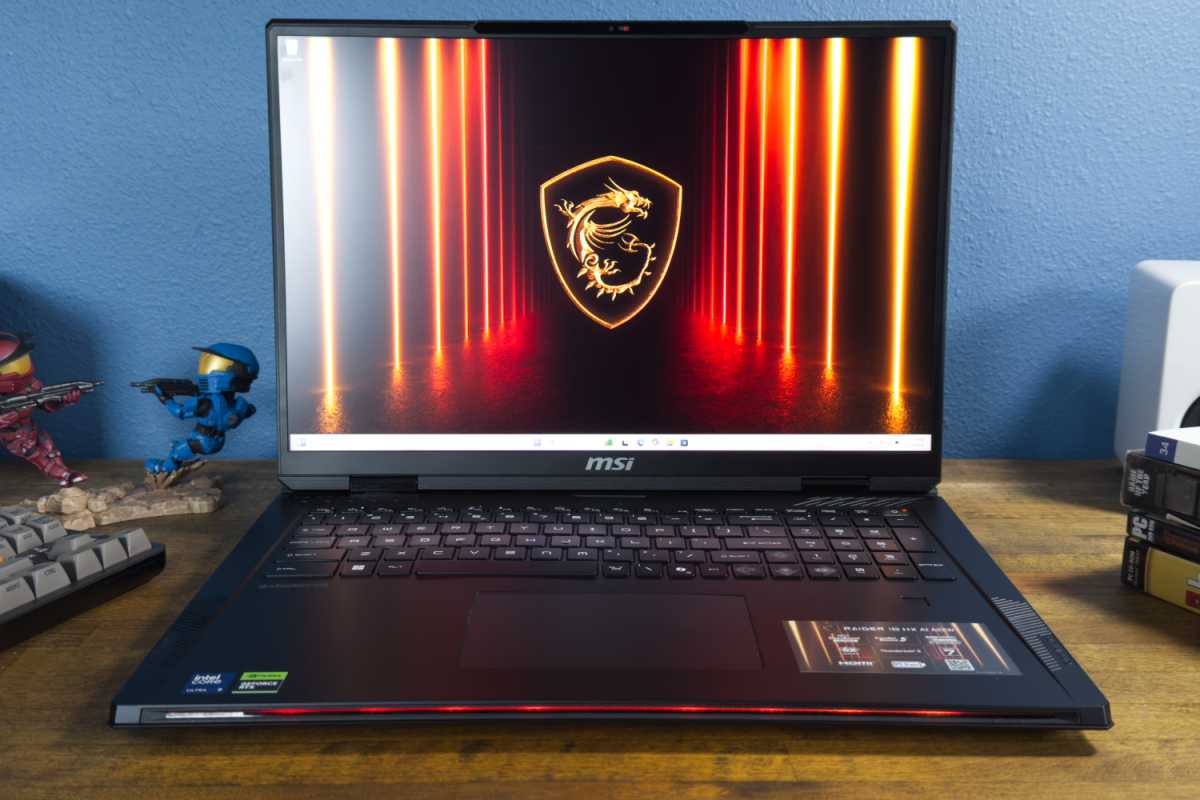
IDG / Matthew Smith
The MSI Raider 18 HX AI has a rare 18-inch Mini-LED display. This type of display combines an IPS-LCD panel with an array of LEDs that can change brightness independently.
That allows the display to achieve an effectively infinite contrast ratio like OLED competitors. It’s not quite as good as OLED, as Mini-LED can suffer “blooming,” an issue that can cause a halo effect around small, bright objects on dark scenes. Still, it’s almost as good.
Contrast aside, the Raider 18 looks great in games and day-to-day productivity apps. Sharpness is a perk, as the display’s 3,840 x 2,400 resolution works out to about 252 pixels per inch (ppi). That’s extremely high (for comparison, a 27-inch 4K monitor typically has 163 ppi).
The display also has a wide color gamut and can become extremely bright, which makes the Raider 18 a decent choice for HDR. Note, however, that HDR is not supported when the laptop is on battery power.
Listening to music on the Raider 18 isn’t as pleasant as watching movies, though it’s still decent. The built-in speakers are upwards-firing and deliver good volume, while a pair of 2-watt woofers offer some low-end oomph. I found the treble rather grating, however, and the sound is muddy with the volume cranked all the way up. Still, it’s good for laptop audio.
MSI Raider 18 HX AI: Webcam, microphone, biometrics
MSI ships the Raider 18 with a 1080p webcam. It provides good video quality in a well-lit to moderately lit room. Viewing the webcam’s output on the Raider 18 itself sells it short, as 1080p is so far below the display’s 3,840 x 2,400 resolution. On Zoom calls, however, the webcam looks good. As a bonus, the webcam provides a physical privacy shutter.
Microphone quality is respectable, as well, with good voice pick-up and decent noise cancellation from the dual microphone array. The Raider 18 also supports Windows’ AI-driven Studio Effects, so it’s easy to blur your background.
Biometric login is supported through Windows Hello. Both facial recognition and fingerprint recognition are available and work well.
MSI Raider 18 HX AI: Connectivity
Connectivity is among the MSI Raider 18 HX AI’s strengths.
It has two Thunderbolt 5 ports, each supporting USB-C, DisplayPort, and Power Delivery. Their high data bandwidth (80 Gbps bi-directional) and versatile feature set make them ideal for connecting to a Thunderbolt dock or Thunderbolt-compatible monitor. From there, these ports can handle multiple downstream peripherals or displays. The laptop also has three USB-A ports, all supporting USB 3.2 Gen 2 speeds (10 Gbps).
In addition to the Thunderbolt 5 ports, the Raider 18 also has an HDMI 2.1 port. It’s rated for 8K output up to 60Hz and 4K output up to 120Hz. A 3.5mm combo audio jack and 2.5G Ethernet port round out the options.
I do have a nitpick. While the dual Thunderbolt 5 ports are excellent to see, they’re both on the same side of the laptop (the right flank). I’d prefer to see one of the ports on the rear, as it would help minimize cable clutter when connecting the laptop to a dock.
Wireless connectivity is strong, too. The laptop supports Wi-Fi 7E and Bluetooth 5.4, which are the latest versions of each standard.
MSI Raider 18 HX AI: CPU Performance
While the Raider 18 HX AI offers many notable features, including a Mini-LED display and Thunderbolt 5 connectivity, performance is the reason to buy the laptop. It has an Intel Core Ultra 9 285HX processor with a total of 24 CPU cores (8 performance and 16 efficient cores) with a maximum turbo clock of 5.5GHz. That’s paired with Nvidia’s new RTX 5080, which has a total of 7,680 shader cores, 240 tensor units, and 16GB of GDDR7 memory on a 256-bit memory bus.
That’s not all. The Raider 18 HX AI supports gobs of RAM; the model I tested had 64GB of DDR5-6400 memory. It also shipped with a 4TB PCIe Gen 5 solid state drive.
Unless otherwise noted, the results shown below represent the Extreme Performance and Discrete Graphics mode, which were the default when the laptop arrived.
So, how does it perform?
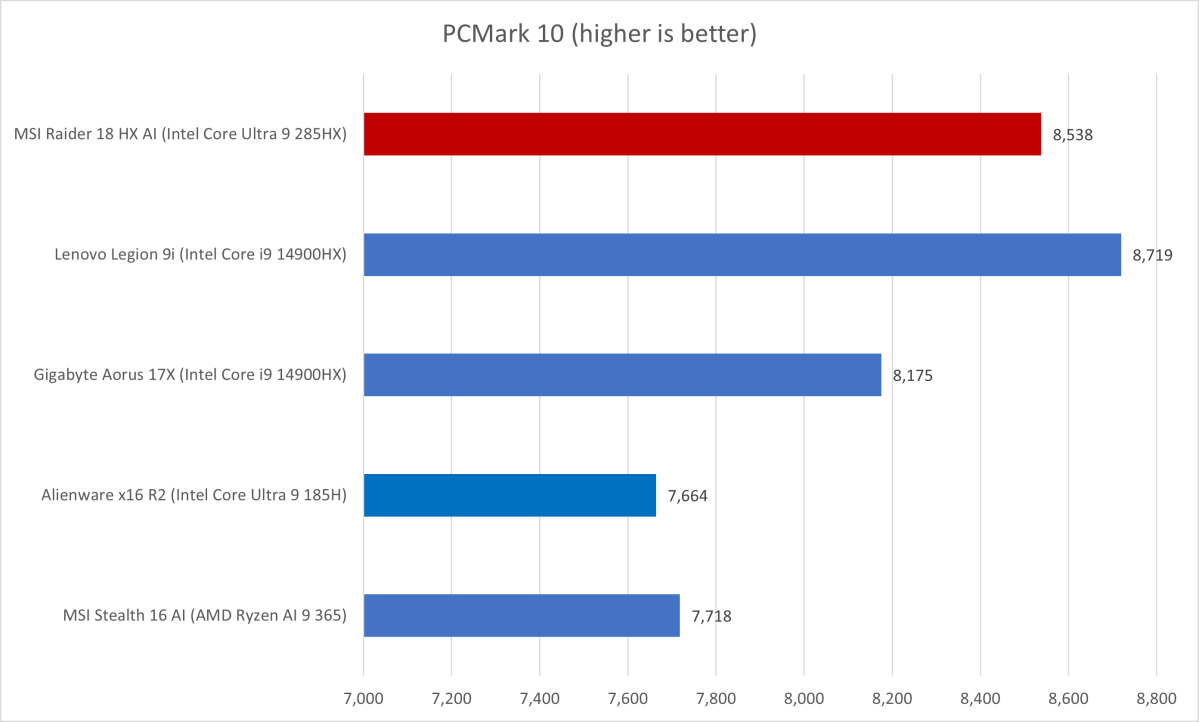
IDG / Matthew Smith
PCMark 10 puts the Raider 18 off to a modest start with an incredible yet slightly underwhelming score of 8,538.
This is an extremely high result that’s about 1,000 points higher than similar high-end laptops sold last year. However, several older laptops, like the Lenovo Legion 9i, achieved a higher score.
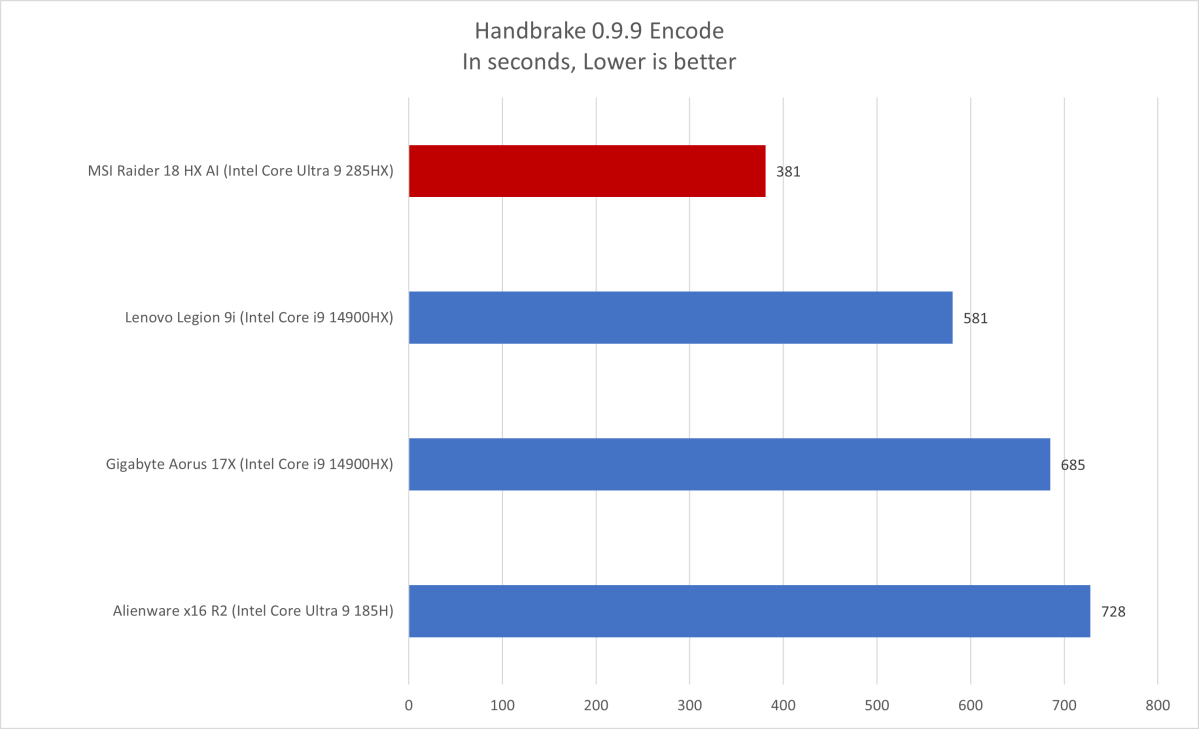
Login to add comment
Other posts in this group

If you use Microsoft Edge as one of your browsers and if you want to

Mechanical keyboard nuts generally love old vintage keyboard designs—
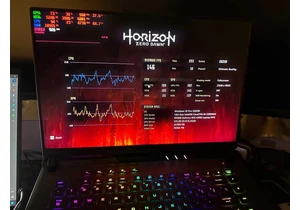
Among all the game stats that I monitor, the Frame Time Graph is the


The current “sweet spot” for gaming monitors is 27 inches and 1440p r

One of our favorite OLED laptops just became a lot more affordable! T

Virtual PCs have important uses, such as providing a dedicated enviro
